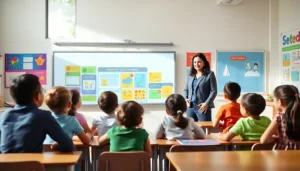Elementary school is often the first big adventure for kids, a journey filled with learning, growth, and probably enough crayons to stock a small art supply store. But when exactly does this educational escapade start and end? Well, buckle up. This article will guide you through the years that define elementary education, ensuring you don’t mix it up with your own questionable P.E. experiences from back in the day.
Table of Contents
ToggleUnderstanding Elementary School Grades

Elementary school typically spans from kindergarten through fifth or sixth grade, depending on the specific education system in place. In many areas, children start kindergarten at age five. So, that means they could be just shy of six when they take their first big step into the classroom.
Typical Age Range for Elementary Students
The age range for students in elementary school generally falls between five and eleven years old. Here’s a quick breakdown of what that looks like:
- Kindergarten: Ages 5-6
- 1st Grade: Ages 6-7
- 2nd Grade: Ages 7-8
- 3rd Grade: Ages 8-9
- 4th Grade: Ages 9-10
- 5th Grade: Ages 10-11
Of course, this can vary based on individual readiness, school district policies, and sometimes the whims of parental decisions.
Starting at such a young age, children are introduced to the basics of reading, writing, and mathematics, not to mention social interactions that they’ll carry throughout their lives.
The Structure of Elementary Education
Elementary education is structured to provide children with foundational skills that they will build upon in later years. Generally, this includes subjects like language arts, math, science, and social studies. Each grade level aims to progressively enhance these skills, ensuring that students are adequately prepared for the next stage of their education.
Courses are designed with age-appropriate learning goals in mind. For example, younger students might focus on basic phonics and simple arithmetic, while older elementary students jump into more complex reading comprehension and problem-solving skills. This progression is vital for a seamless transition into middle school, where subjects become more specialized.
Variations in Elementary School Years by State
Interestingly, the structure of elementary school can differ significantly from one state to another. While most follow the kindergarten to grade five model, some states might extend this to sixth grade or even incorporate multi-grade classrooms where students might learn together across different levels.
Transitioning From Preschool to Elementary School
The leap from preschool to elementary school can be monumental for children. In many cases, local education boards provide guidelines to ease this transition. This may include curriculum alignment to ensure kids are ready, orientation days to familiarize families with the new environment, and resources to support children facing the challenge of adjusting to a more structured educational setting.
The Importance of Early Education
Early education during elementary years significantly shapes children’s future learning experiences. The skills and knowledge gained during these formative years lay the groundwork for advanced learning in middle and high school. As children explore subjects like math and reading, they also develop social and emotional skills that are crucial for later success.
Differences in Curriculum Across Elementary Years
Curriculum varies not just by state but even by school district and individual schools within the same area. In general, early grades tend to emphasize hands-on learning and play-based strategies. As students move to higher grades, the focus smartly shifts towards a more formalized educational approach with increased expectations about assessments and standardized testing.
Parents often play a vital role in understanding these differences. Finding ways to enhance their child’s learning experience outside of school hours, through reading at home, educational games, and open discussions about daily classroom experiences, can foster a more rounded educational journey.











